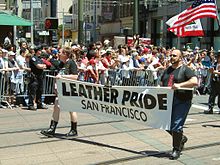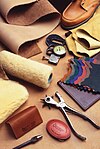
| Home | Title Index | Topic Index | Expert Directory | News Releases | Calendar | Articles |
Leather subculture
| The examples and perspective in this article deal primarily with the United States and do not represent a worldwide view of the subject. Please improve this article and discuss the issue on the talk page. (August 2010) |
|
|
This article may require cleanup to meet Wikipedia's quality standards. Please improve this article if you can. |

The leather subculture denotes practices and styles of dress organized around sexual activities. Wearing leather garments is one way that participants in this culture self-consciously distinguish themselves from mainstream sexual cultures. Leather culture is most visible in gay communities and most often associated with gay men ("leathermen"), but it is also reflected in various ways in the gay, lesbian, bisexual, and straight worlds. Many people associate leather culture with BDSM (Bondage/Discipline, Dominance/Submission, Sado/Masochism, also called "SM" or "S&M") practices and its many subcultures. But for others, wearing black leather clothing is an erotic fashion that expresses heightened masculinity or the appropriation of sexual power; love of motorcycles and independence; and/or engagement in sexual kink or leather fetishism.[1]
Contents |
[edit] History
[edit] Popular and social origins
Gay male leather culture has existed since the late 1940s,[1] when it likely grew out of post-WWII biker culture. Early gay leather bars were subcultural versions of the motorcycle club. Pioneering gay motorcycle clubs included the Satyrs, established in Los Angeles in 1954; Oedipus, also established in Los Angeles in 1958, and the New York Motorbike Club. Early San Francisco clubs included the Warlocks and the California Motor Club.[2]
These clubs, like the motorcycle culture in general, reflected a disaffection with the mainstream culture of post-World War II America, a disaffection whose notoriety â and therefore appeal â expanded after the sensationalized news coverage of the Hollister "riot" of 1947. The 1953 film The Wild One starring Marlon Brando wearing jeans, a T-shirt, a leather jacket, and muir cap, played on pop-cultural fascination with the Hollister "riot" and promoted an image of masculine independence that resonated with some gay men in a culture which stereotyped gay men as effeminate. To that end, gay motorcycle culture also reflected some men's disaffection with the coexistent gay cultures more organized around high culture, popular culture (especially musical theater), and/or camp. Perhaps as a result, the leather community that emerged from the motorcycle clubs also became the practical and symbolic location for gay men's open exploration of kink and S&M.[2]
[edit] Representations
The more specifically homoerotic aesthetics of men's leather culture drew on other sources as well, including military and police uniforms. This influence is particularly evident in the graphical illustrations of leathermen found in the work of Tom of Finland. The pornographic films of one of his models Peter Berlin, such as his 1973 film Nights in Black Leather, also reflected and promoted the leather subcultural aesthetic.
Aspects of leather culture beyond the sartorial can also be see in the 1970 murder mystery novel âCruisingâ by Jay Green. The novel was the basis for the 1980 movie âCruising,â which depicted aspects of the men's leather subculture for a wider audience.
Rob Halford, the lead singer of heavy metal band Judas Priest, openly identifies as gay and wears black leather.
And lastly, perhaps no figure has more vividly represented the leather subculture in the popular imagination than the leatherman portrayed by Glenn Hughes of the Village People.
[edit] Association with BDSM
In recent decades the leather community has been considered a subset of BDSM culture rather than a descendant of gay culture. Even so, the most visibly organized SM community has been a subculture of the gay community, as evidenced by International Mr. Leather in the US (established 1979) and SM Gays in the UK (established 1981). Meanwhile, other subcultures have likewise appropriated various leather fashions and practices.
[edit] GLBT
The Leatherman's Handbook by Larry Townsend, published in 1972, epitomizes the association of the leather subculture with BDSM.[3]
It is said that, in this era, there existed something now called old guard leather culture. The old guard code emphasizes strict formality and fixed roles (i.e. no switching). Other old guard practices emphasize discipline, honor, brotherhood, and respect, and are said to promote a stricter lifestyle, education, and intra-community privilege based on successive ranks or levels.[citation needed]. A person would enter a leather family as a slave, then graduate to boy, sir, and finally Master. Rarely, if ever, was an individual allowed to "stay as a slave," although that might be the individual's leaning.
In the early 1980s and perhaps before, there was a rebellion against the old guard role rigidity. There was a new emphasis on choices, or identity: A person might identify as a slave or a Master instead of being forced to start from the bottom and work up. It took a while, but eventually there was an acceptance of these individual identities. The eighties was an era of pushing the edge in BDSM play. Of course, the AIDS epidemic put a bit of a damper on this. Leather and motorcycle groups suffered and some perished altogether. But the leather community as a whole survived and lead into the brave new world of the 1990s.
Interestingly, those of us who lived in leather during the 1980s called our leather "new guard" and now that term has a new meaning. I guess we were the "middle guard."
New guard, or new leather, which describes an era in leather culture that started in the early 1990s, embraced switching and a greater variety of approaches to eroticism.[citation needed] An increasing number of pansexual clubs evolved as well.[citation needed]
[edit] Goth
Leather subcultural practices have also become a common, though perhaps not widespread, element of the goth subculture.
[edit] Demographics
Relatively few lesbian women or heterosexuals were visible during the early emergence of the leather subculture. Pat Califia, who was a lesbian activist in the San Francisco leather subculture, is credited for defining the emergence of lesbian leather subculture. In 1978, Califia co-founded one of the first lesbian S/M groups, Samois. Califia became a prolific contributor to lesbian and BDSM literary erotica and sex guides.
Although Samois may have been the first lesbian BDSM group, it was not alone for long. lesbian BDSM groups emerged in Los Angeles and New York in the early 1980s. Leather and Lace, a woman's BDSM support and social group, was founded in Los Angeles in 1980 by Jody, Jamie and ______. The women of Leather and Lace learned the "old guard" traditions from the men of Avatar. Leather and Lace had a code of conduct, a uniform that could only be work once a member earned the right. In New York, there was LSM. Only members of the club were allowed to know that LSM stood for Lesbian Sex Mafia.
Although gay men are the most visible symbol of the leather community, in 2010 there are numerous lesbians who identify as leatherwomen. One example of a visible female involved with leather pride is Joan Jett, who has a leather pride sticker prominently displayed on her guitar.
In North America, with the possible exception of Quebec, gay men's leather culture continues to be associated with men above the age of 40.[citation needed]. As of 2010, this is changing. The kink/fetish/gear communities are merging with the leather community and there is an emergence of young leathermen and leatherwomen. In Europe younger men have combined the aesthetic and exploration of sexual power with the gay skinhead movement and social-fraternal organizations like BLUF.
Today, while some may still use the term strictly in the old fashioned sense (i.e., Old Guard), more than ever the leather subculture in the 21st century represents the activities of several major sub-communities.[1] These include BDSM practitioners, whether high or low protocol, and whether gay, lesbian, straight, bisexual, or pansexual. They also include people who have a preference for aggressive or masculine sexual styles; people who love motorcycles; people involved in kink or leather fetishism; and people who participate in large-scale cultural and marketing events such as Folsom Street Fair or leather-themed circuit parties.
[edit] Events
Several major cities host Leather Pride events, including San Francisco's Folsom Street Fair and International Ms Leather, New York City's Folsom Street East, Palm SpringsTurning Up The Heat, Toronto's Leatherball and Mr. Leatherman Toronto, Chicago's International Mr. Leather, Montreal, and Berlin.
[edit] Influence on mainstream
Styles of dress associated with gay men's leather culture also had influence on mainstream pop culture. It may be seen in the chains and leather or denim and leather look espoused by heavy metal bands. The first practitioner of this look in a heavy metal context was Rob Halford, the lead singer of the influential NWOBHM band Judas Priest. Halford (who is himself openly gay) wore a leather costume on stage as early as 1978, a look he described as originating in the gay leather subculture.[4] The subsequent influence of his costume may be seen in many metal bands, particularly in the widespread and creative appropriation of the codpiece in metal rockers' costumes.
[edit] Museums and exhibitions
The 10,000 square foot, two-story Leather Archives and Museum, based in Chicago, has much information and details on the beginning of the leather subculture.
In addition to activities in Chicago, the LA&M serves the leather world by preserving material from various leather communities, and sends traveling exhibits around the country.
In 2005, Viola Johnson started traveling with her collection and telling stories from her 35 years of personal involvement in the leather subculture.
[edit] See also
- Hanky code
- BDSM
- Daedalus Publishing
- Folsom Street Fair
- International Mister Leather
- International Ms. Leather
- Leather Archives and Museum
- Leather fetishism
- Leather Pride flag
- Mister Leather Europe
- Mr. Slave
- National Leather Association International
- Southeast Leatherfest
[edit] Notes
- ^ a b c "Elegy for the Valley of Kings," by Gayle Rubin, in In Changing Times: Gay Men and Lesbians Encounter HIV/AIDS, ed. Levine et al., University of Chicago Press
- ^ a b Rubin, Gayle. "The Miracle Mile: South of Market and Gay Male Leather, 1962-1997" in Reclaiming San Francisco: History, Politics, Culture (City Light Books, 1998).
- ^ Townsend, Larry (1972), The leatherman's handbook, Modernismo, OCLC 63248803
- ^ McCormick, Neil (8 December 2008). "Turn on tune in but who's dropped out?". The Telegraph. http://www.telegraph.co.uk/culture/music/3665242/Turn-on-tune-in---but-whos-dropped-out.html.
[edit] Further reading
|
|
This article's further reading may not follow Wikipedia's content policies or guidelines. Please improve this article by removing excessive, less relevant or many publications with the same point of view; or by incorporating the relevant publications into the body of the article through appropriate citations. (August 2010) |
- Gayle Rubin: Leather Times, Samois 2004, 21:3-7. Online unter leatherarchives.org
- Samois. What Color is Your Handkerchief: A Lesbian S/M Sexuality Reader. SAMOIS; Berkeley 1979.
- Samois: Coming to Power. Writings and Graphics on Lesbian S/M. Alyson Publications, Boston, 3. Auflage Oktober 1987, ISBN 0932870287
- Pat Califia: "A Personal View of the History of the Lesbian S/M Community and Movement in San Francisco". in: Coming to Power: Writings and Graphics on Lesbian S/M
- Pat Califia (Hrsg.), Robin Sweeney (Hrsg.): The Second Coming: A Leatherdyke Reader. Alyson Pubns, 1996, ISBN 1555832814 (enthält u.a. eine Schilderung Gayle Rubins über die Geschichte der Outcasts.)
- Pat Califia: Sapphistry: The book of lesbian sexuality, Naiad Press, 1988, ISBN 0-941483-24-X
- Pat Califia: Speaking Sex to Power: The Politics of Queer Sex (Essays), Cleis Press, 2001, ISBN 1-57344-132-5
- Gayle Rubin: Thinking Sex: Notes for a Radical Theory of the Politics of Sexuality. In: Henry Abelove u.a. (Ed.): The Lesbian and Gay Studies Reader, New York (Routledge). 1993. (1st Ed. 1984.)
- Gayle Rubin: Samois, in Marc Stein (Hrsg.), Encyclopedia of Lesbian, Gay, Bisexual, and Transgender History in America, Charles Scribnerâs Sons, 2003. PDF download
- Gayle Rubin: The Valley of the Kings: Leathermen in San Francisco, 1960-1990., 1994, Dissertation Abstracts International, 56 (01A), 0249. (UMI No. 9513472).
- Gayle Rubin: Sites, Settlements, and Urban Sex: Archaeology And The Study of Gay Leathermen in San Francisco 1955-1995, in Robert Schmidt and Barbara Voss (Ed.): Archaeologies of Sexuality, London, Routledge, 2000, ISBN 0415223652
- Nancy Peters (Hrsg.): Reclaiming San Francisco: History, Politics, Culture, San Francisco, City Lights Books, 1998, ISBN 0872863352
- Gayle Rubin: From the Past: The Outcastsfrom the newsletter of the Leather Archives & Museum No. 4, April 1998
[edit] External links
- International Mr. Leather
- Leather Archives & Museum
- Leather History Timeline from LA&M
- The Sydney Leather Pride Association (Australia)
- Colors-of-Leather
- International Ms Leather
- Leather Clubs Directory
- BLUF Chicago's website
- Mid-Atlantic Leather
- Leather specilities
|
||||||||||||||||||||||
|


